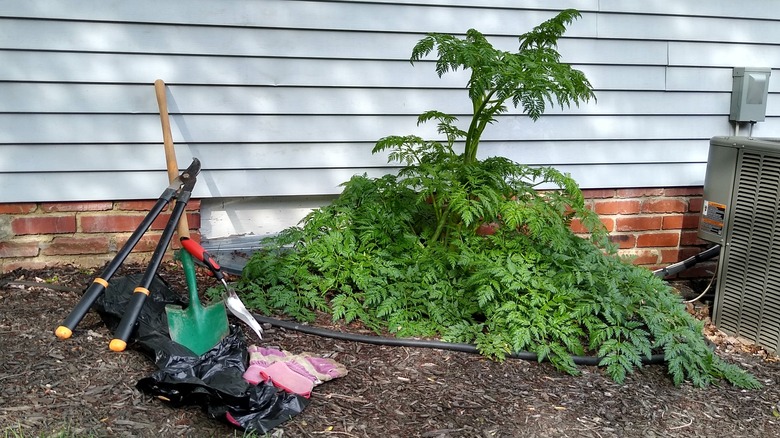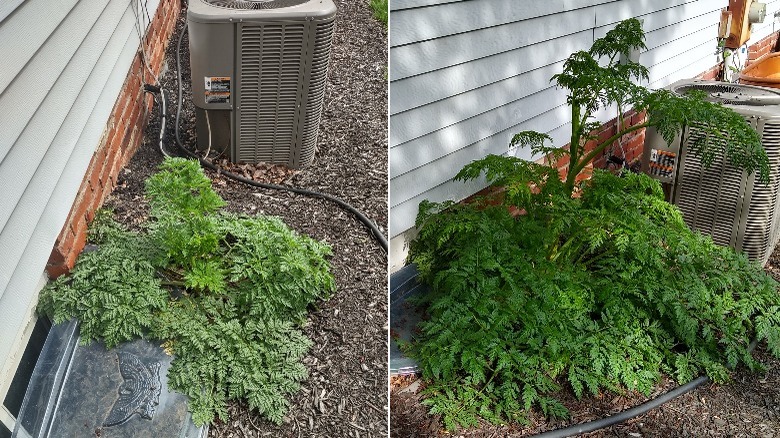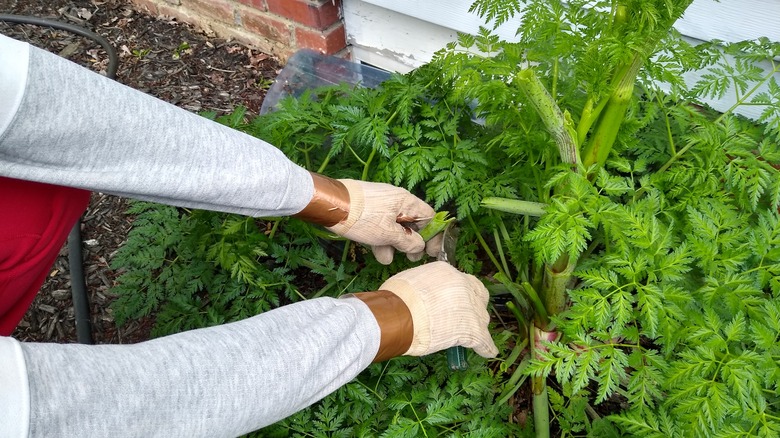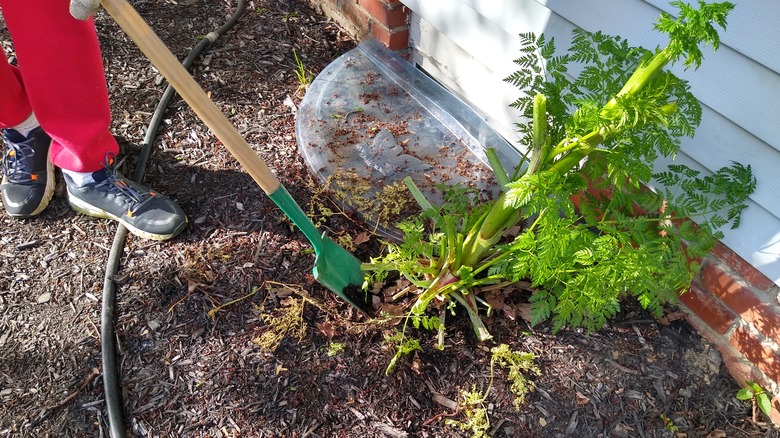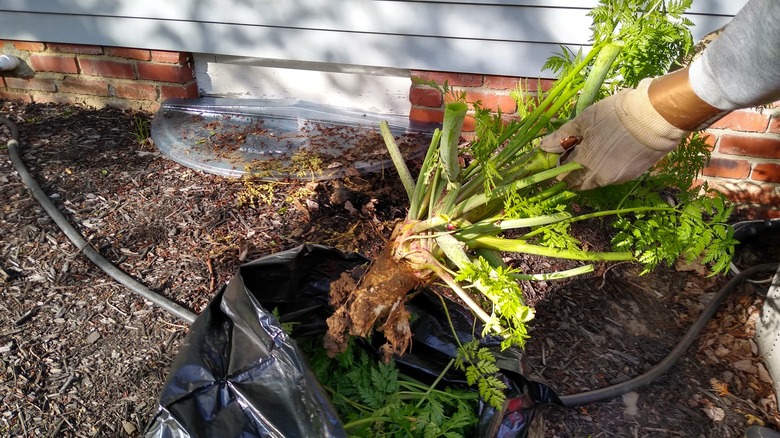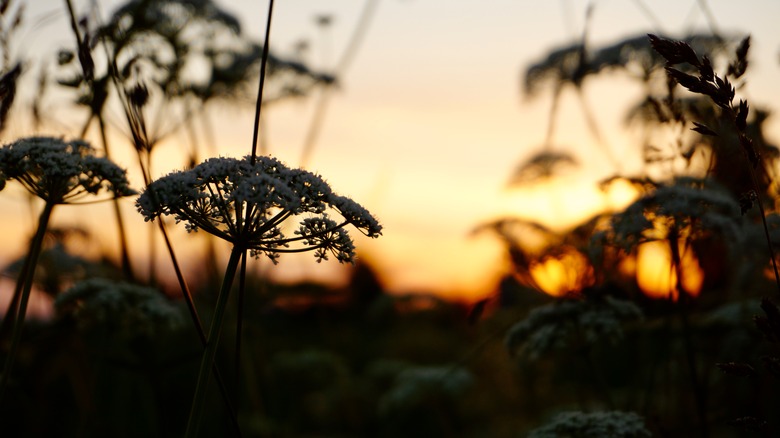How To Recognize And Remove Poison Hemlock From Your Yard
When your husband comes to you (the gardener of the household) in early spring and says there is something bright green flourishing on the side of the house, one might think that it's a cause for celebration. "Huzzah," cries the inner voice, apparently channeling horticulturists of antiquity. But the celebration doesn't last long. If it's flourishing that early in the season, in an area where you didn't plant anything, not far from the former home of a rather scary weed that hitchhiked in with a load of mulch last fall, it's probably bad news. Unsurprisingly, the bright green, ferny-leafed plant was quickly identified as none other than poison hemlock.
Yes, that poison hemlock, Conium maculatum – made into a tea that killed Socrates – and all parts of it are very toxic. Furthermore, these toxins exist years after the plant dies. Poison hemlock is also sneaky. It can be mistaken for less dangerous plants, such as Queen Anne's lace (also known as wild carrot), but poison hemlock's telltale spots or streaks of purple on its smooth, hairless stems give it away. Michigan State University charts other differences between the two carrot family relatives, including the hemlock's hollow stems and telltale smell when its leaves are crushed. Knowing which is safe and which is dangerous is the first step to getting rid of the bad one.
Don't wait to get rid of poison hemlock
Removing poison hemlock during the first year of growth is the best way to keep it from becoming a larger problem. It's still highly toxic, but is far easier to manage in the first year of biennial growth. Poison hemlock begins as a ground-hugging rosette of ferny leaves with a triangular growth pattern. Even if you aren't sure if the weeds are poison hemlock, it's wise to yank them out, getting as much of the root as you can. They are relatively easy to remove when they're in the first year of growth. But remember that all parts of the plant are toxic, so put on your garden gloves!
On the other hand, removing poison hemlock in the second year when it's bigger and more dangerous is a complicated task. For this, you may want to break out the duct tape to ensure there are no gaps between your gloves and long-sleeved shirt. However, you can probably stop short of wrapping yourself or the main hemlock digger in bubble wrap.
Be sure your protective clothing includes long pants, thick socks, and sturdy shoes. It's also wise to have eye goggles and a face mask handy. While not everyone encounters skin sensitivity, toxins can enter through the eyes, nose, mouth, or broken skin.
Taming the monster
During its second year, poison hemlock grows very quickly and can go from its ground-hugging initial state to a height of 3 feet in just a month or two. The plants can top out at 8 to 12 feet.
To dig out a large plant without having it touch you more than necessary, trim it to a manageable size. Begin slowly and methodically, working with stems that are easily cut from the plant's main stem. This allows you to gradually see and work around the central part of the plant without having it creep into your personal space.
Using hand pruners or loppers, cut off a piece near where it meets the main stem of the poison hemlock. You'll likely notice that the cut stem is hollow and has identifying purple streaks or spots. Place the cutting and any broken pieces into a plastic garbage bag to be discarded. Never compost or recycle poison hemlock.
Work your way around the plant, trimming off stems until you feel like you have a clear view of and access to the base of the weed. Once you get to that point and the top is trimmed enough that it won't brush your face as you bend forward, you're ready to dig. However, remember to clean the toxins off your tools when finished. Hot water and a degreasing dishwashing detergent should do the job.
Digging around the root of the poison hemlock plant
Videos abound of people throwing on a pair of garden gloves (or sometimes not, if you can believe it), grabbing a trowel, and quickly scooping up poison hemlock to dispose of it. They make it look easy, but don't be deceived.
First, be cautioned again that every leaf, stem, seed, and root of the plant is toxic and remains so even years after it's dead. Remember that if you have a large poison hemlock weed to excavate, you'll want to take the time to cut branching stems so that you can get to the base of the plant. Now that you have a clear view of the anchor point, determine where you think the root is. Then, consider the soil conditions: Is the area rocky, dense, loamy, or heavy with clay? Will you need to break through landscape fabric (if so, you'll need a cutting tool)? Is the weed growing against a structure where it might be going under or around something stationary? The answers to these questions will determine the tools you'll need.
Have several tools ready, including a garden spade or shovel (ones with pointed ends can be helpful), a weed puller (one with a serrated edge can help if there are entangled roots from nearby vegetation), a hand saw (in case you encounter large roots), and sharp scissors (for cutting through landscape fabric).
Disposing of poison hemlock
This is one time when composting is a terrible idea. You don't want poison hemlock in your compost bin or the recycling bins collected at the curb. Be sure to place all plant parts in sturdy plastic trash bags, securely close or tie them, then properly discard them. If you're dealing with a large hemlock, cutting it into smaller pieces can help you get it into the bag more easily. However, be aware that you could release toxins into the air with each snip, so wear protective eye goggles and a face mask.
The University of Minnesota Extension office counsels that you'll want to check with your trash collector to make sure they'll accept the weeds, and if they don't, the bags may have to be buried in a location that won't be disturbed. A good rule of thumb is to contact your local invasive weed control office or U.S. Department of Agriculture extension service office (you can look it up here) to seek advice. In general, it's never a bad idea to talk to the extension service; you can get regionally-specific answers to your questions about things like gardening, pest control, or your lawn.
Preventing poison hemlock from returning
Like a bad house guest, poison hemlock doesn't want to leave. If you didn't remove all the roots, you could see leaves poking out of the soil again. If you caught it too late and a seed or two escaped, a new plant might grow. So keep an eye on the area over the course of a year (or two) to be sure it isn't coming back.
Thinking about mowing the patch? The Ohio State University Extension Office says that if you mow in the first year when the weed is a low-growing rosette, it's too early and may escape the blades. However, waiting until it has begun to flower during the second year is too late. Mowing is only effective in the second year of growth when poison hemlock has started to bolt and grow upright but before it flowers.
You might also be tempted to set a match to it, but don't burn poison hemlock, even if you have large areas where it is flourishing. As with poison ivy, burning the plant releases toxins into the air.
Even if you think you eradicated the poison hemlock, it can still return. So watch for those bright green leaves in the early spring, and be ready to pull on those gloves. Of course, knowing what poison hemlock is, you won't be shouting "huzzah" when you see it once again.
